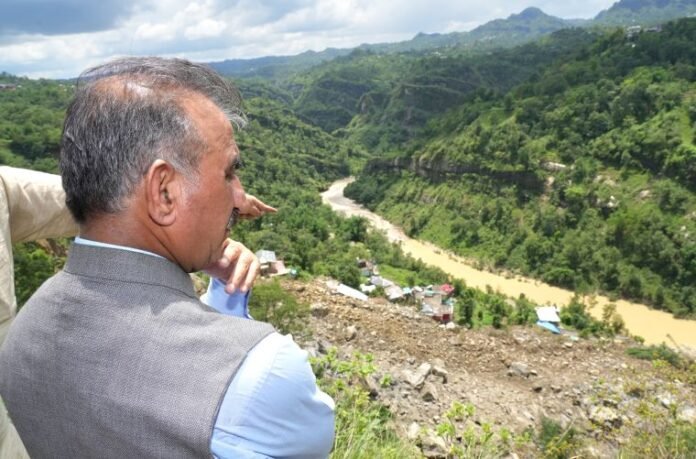In the wake of a devastating cloudburst that ravaged Syathi village in the Laungani Panchayat of Dharampur in Himachal Pradesh’s Mandi district, Chief Minister Thakur Sukhvinder Singh Sukhu arrived on-site to assess the extent of the destruction and offer solace to the affected families. The village, now reeling from the aftermath of the violent downpour, has emerged as a stark symbol of the increasing vulnerability of Himalayan communities in the face of climate disasters. As residents attempt to recover from the shock, the Chief Minister’s visit brought a measure of reassurance and a strong message of government support in a moment of acute distress.
Speaking to the villagers, many of whom had barely survived the furious surge of water and debris, Chief Minister Sukhu extended heartfelt condolences and promised robust support for rebuilding their lives. Families recounted harrowing experiences of homes being swept away in minutes, cowsheds crumbling under forceful water currents, and livestock perishing. One villager described the event as a complete erasure of their world, lamenting that they no longer had even a patch of land on which to pitch a shelter. The Chief Minister, visibly moved by the scenes of devastation, assured that wherever possible, alternative land would be allotted to families rendered homeless. In cases where nearby land is forested and falls under central jurisdiction, he pledged to take up the matter directly with the Union Government.
The Chief Minister revealed that 61 individuals had been displaced by the disaster and were evacuated in time to relief camps set up by the district administration. Emergency support in the form of ration kits, tarpaulins, and financial assistance of ₹1.70 lakh has already been distributed. However, beyond immediate relief, the Chief Minister emphasized that a special relief package was being prepared to rebuild damaged homes and offer enhanced compensation for destroyed livestock and property. He also assured that restoration of essential services and damaged roads, particularly the critical Mandi-Kotli link, was underway on a priority basis.
While touring the area and interacting with local residents, Sukhu reiterated that such extreme weather events were no longer anomalies but signs of a larger, more troubling shift. He acknowledged that in a single night, nearly 8 to 10 cloudbursts had struck different parts of Mandi district, an unprecedented meteorological phenomenon even by Himalayan standards. The Chief Minister called for a joint initiative between the Centre and the State to commission an in-depth scientific study into the underlying reasons for these landslides and cloudbursts, particularly in regions where the geology was previously considered stable. His remarks underlined the increasing urgency of climate resilience strategies, not just disaster relief.
The scale of tragedy was further compounded by the confirmation of human loss. Ten people have been reported dead across the district, while 34 others remain missing. The most severely affected areas include Gohar, Thunag, Jogindernagar, and Karsog subdivisions. The identification of deceased individuals is still underway, while search and rescue teams continue combing the disaster-hit zones, many of which remain inaccessible due to landslides and broken roads.
Local MLA Chander Shekhar, who accompanied the Chief Minister during the visit, expressed deep gratitude for the prompt government response. He lauded Sukhu’s immediate presence in the worst-affected zone and commended his commitment to not only offering words but swiftly initiating concrete relief measures. In a region where terrain and weather often delay state response, the Chief Minister’s physical presence and empathy were widely appreciated.
As the state grapples with rising rainfall intensity and its deadly consequences, the events in Mandi mark yet another grim reminder that mountain states like Himachal Pradesh are on the frontlines of climate volatility. The synergy between timely political will, administrative execution, and long-term planning will be crucial in determining how well the state navigates these repeated catastrophes. While the grieving continues and rebuilding begins, Mandi today stands as both a scene of heartbreak and a site of hope—thanks in part to leadership that meets tragedy not just with sympathy, but with action.
#MandiCloudburst #HimachalFloods #CMsukhu #ClimateDisaster #ReliefAndRehabilitation
This is an auto web-generated news web story.




